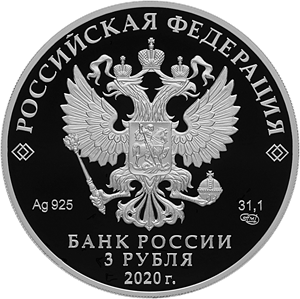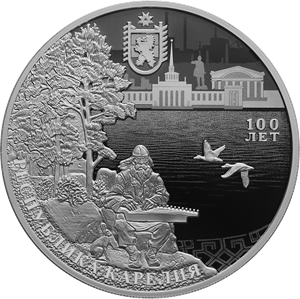100th Anniversary of the Foundation of the Republic of Karelia
Obverse
the mirror field of the disc bears a relief image of the National Coat of Arms of the Russian Federation, over it along the rim there is the semicircular inscription ‘РОССИЙСКАЯ ФЕДЕРАЦИЯ’ (RUSSIAN FEDERATION) framed on both sides by doubled rhombuses, below under the coat of arms there are indications of the precious metal and its fineness on the left and the fine metal content and the mint trade mark on the right, at the bottom in the centre, in three lines, there is an inscription ‘БАНК РОССИИ’ (BANK OF RUSSIA), the denomination of the coin ‘3 РУБЛЯ’ (3 RUBLES), and the year of issue ‘2020 г.’ (2020).
Reverse
the mirror field of the disc bears relief images of the emblem of the Republic of Karelia, a figure of a traditional singer of epic songs – a rune singer, natural landscape, a rabbit and a pair of ducks flying above the water surface, a stylised image of buildings of the capital of Karelia, Petrozavodsk, in the background, and a national ornament at the bottom on the right; there are inscriptions: ‘РЕСПУБЛИКА КАРЕЛИЯ’ (REPUBLIC OF KARELIA) below on the left along the rim and ‘100 ЛЕТ’ (100 YEARS) on the right in two lines.
Authors
Designers: E.V. Kramskaya (obverse), A.V. Gnidin (reverse).
Sculptors: A.A. Dolgopolova (obverse), A.V. Gnidin (reverse).
Mint: Saint Petersburg Mint (СПМД).
Edge: 300 corrugations.
Discover more
People started to populate the territory of Karelia in the 7–6th centuries BC. After the foundation of the ancient Russian state Kievan Rus in the 9th century, the territory of Karelia came under its control. When Kievan Rus disintegrated in the 12th century, Karelia became part of the Novgorod Feudal Republic. In 1478, Karelia and other lands of Veliky Novgorod merged into the Russian state. In the 18th century, a considerable territory of Karelia was part of the Petersburg Province and, later on, of the Novgorod Province. In 1784, Karelia was part of the newly founded Olonets Province with its capital in Petrozavodsk. The remaining territory was integrated into the Vyborg and Arkhangelsk Provinces.
On 8 June 1920, the Russian Central Executive Committee approved a decree to integrate the areas of the Arkhangelsk and Olonetsk Provinces populated by the Karelians into the autonomous region – the Karelian Labour Commune. On 25 July 1923, pursuant to the resolution of the Russian Central Executive Committee, the Karelian Labour Commune was reorganised into the Karelian Autonomous Soviet Socialist Republic. On 13 November 1991, the Karelian ASSR was renamed as the Republic of Karelia.
Today, owing to its advantageous geopolitical location, unique environment, abundant recreational resources, and centuries-old cultural and historical heritage, Karelia holds a special place in the tourism market. Karelia possesses thousands of original historical and cultural landmarks, nature sanctuaries, and historical sites of global and nation-wide importance, including the Kizhi Architectural Ensemble, the Valaam Monastery of the Transfiguration of the Saviour, Karelian petroglyphs (Onega Lake and White Sea petroglyphs), rune-singing villages that originated the runes of the Kalevala epos, and the Saami stone labyrinths and seidas. Over one million hectares of Karelia’s territory, which is 5.6% of the republic’s total area, are specially protected natural sites: the Paanajarvi, Vodlozersky and Kalevalsky National Parks, the Valaam Archipelago Natural Park, and the Kivach and Kostomuksha Nature Reserves. The Republic of Karelia tops Russian tourists’ adventure travel rating.
Source: http://old.gov.karelia.ru


